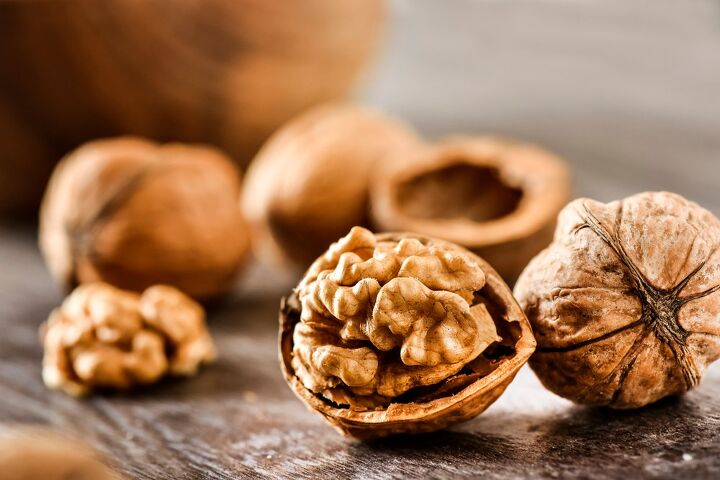Why Are Walnuts So Expensive? (Find Out Now!)

If you’ve ever made a trip to the grocery store and have made a stop in the nut aisle, you’ve probably found yourself wondering why they are so expensive. We’re here to tell you there are actually many good reasons for these high prices. Specifically, we’re going to be talking about walnuts.
Walnuts cost approximately $8.50 per pound, which is middle-of-the-road when compared to many other nuts, but they’ll still cost you a pretty penny. There are a handful of reasons why walnuts cost a lot, and they can be boiled down to their growing conditions, yields, high demand, transportation costs, labor costs, and high taxes.
We’re going to go over all things walnuts in this article, including how they’re harvested, processed, and transported as well as the many health benefits they provide and more. We may not be able to make them cheaper, but we can at least explain why they cost as much as they do.
Cost Factors for Walnuts
Walnuts are tree nuts, which really just means they are grown on trees. This simple fact actually has a lot to do with why walnuts are so expensive. There are a handful of different factors that cause the high price tag on walnuts. We’re going to look at all of them.
Specific Growing Conditions
Walnut trees are native to Asia, Europe, and North America, and they need very specific conditions to grow. These types of trees thrive when they have full sun exposure and well0-drained soil.
They grow best in the foothills and seaside areas that have good drainage. More specifically, they need sandy loam that is well-irrigated and rich in organic materials. They are also very sensitive to high concentrations of sodium, chlorine, and boron, so you should avoid that.
Low Annual Yields
Native walnuts are usually ready to harvest between September and October and can only be collected once a year. Since they only grow in specific areas and conditions, there’s only a limited quantity harvested each year.
This low supply causes them to be priced higher for two reasons. Mainly, it’s to ensure a profit on the yield. On the consumer end, it means walnuts are more of a delicacy than a common purchase, so it’s price equates to its exclusivity.
High Demand
Walnuts are more in demand than they used to be and basic rules of supply and demand will tell you that the bigger the demand, the higher the price. Plus, as we said above, walnut trees produce a small yield, which further drives that price up.
Transportation Costs
Simply put, transporting walnuts is expensive. Even the distance between the production area and the processing plant can raise the overall cost of walnuts. After that, the walnuts also have to make it to a supplier until it finally gets to the consumer.
Furthermore, walnuts are considered a risky food to transport and sell since so many people are allergic to tree nuts. For this reason, people in the nut industry have to stick to strict regulations revolving around sanitation and food safety.
This includes undergoing long and expensive tests in a factory before production can even begin. The overall price of the walnuts you buy at the store has to account for the cost of these procedures or else companies will not make a profit.
Labor Costs
Thanks to all these factors we’ve already talked about, walnuts are a complicated product to harvest and sell. The small yields, the strict regulations, and the specific conditions all drive labor costs up, which in turn raises the cost to buy the walnuts in the end.
High Taxes
All but products, in general, are taxed by both the distributor and the consumer, which means the overall price needs to be higher to ensure a profit. Since nuts also offer so many health benefits, people are continuing to tax them at higher rates than any unhealthy foods on the market. The more we learn about these benefits, the higher the taxes will become.
Health Benefits of Walnuts
Walnuts are known to improve brain health and prevent heart disease and even some forms of cancer. They are made up of approximately 65% fat and 15% of protein. The fat levels in walnut make them a high-calorie snack. That means they’ll give you a good amount of energy throughout the day.
That said, studies indicate that they won’t increase obesity risk when eaten in moderation. They also contain other helpful acids, vitamins, and minerals, including:
- Omega-3 fat alpha-linolenic acid (ALA): acid that helps reduce inflammation and improve blood fats.
- Copper: mineral that promotes heart health and maintains bone, nerve, and immune system function.
- Folic Acid: vitamin that helps your body make red blood cells and improves heart health.
- Phosphorus: mineral in your bones that manages your energy storage, reduces muscle pain, repairs and maintains tissues and cells, produces DNA and RNA, and more.
- Vitamin B6: vitamin that strengthens your immune system and supports nerve health.
- Manganese: trace mineral that impacts fat and carbohydrate metabolism, calcium absorption, and blood sugar regulation.
- Vitamin E: vitamin that can prevent coronary heart disease and inflammation and support immune function and eye health.
- Ellagic Acid: antioxidant that can reduce your risk of heart disease and cancer.
- Catechin: flavonoid antioxidant that promotes a healthy heart and brain and increases energy levels.
- Melatonin: powerful antioxidant that reduces risk of heart disease and helps regulate your body’s internal clock.
- Phytic acid: beneficial antioxidant that can protect against kidney stones and some cancers.
Types of Walnuts
Walnut trees are classified under the plant genus Juglans, which is of the family Juglandaceae. They are native across Asia—especially China—North America, and Europe. There are over 20 different types of walnut trees in the world. The most popular types of walnuts include…
- Andean walnut
- Butternut
- Colombian walnut
- English walnut
- California black walnut
- Little walnut
Common Uses for Walnuts
The obvious thing people do with walnuts is eat them on their own as a snack. However, you can also add walnuts to many different dishes to enhance the taste. Some popular dishes include:
- Salads
- Pastas
- Cereals
- Oatmeal
- Soups
- Baked Goods
- Dips and Sauces
- Trail Mixes
…and more!
The Cost of Common Types of Nuts
The truth is most nuts are expensive for a lot of the same reasons as walnuts, so you’re going to run into this problem no matter what type you decide to buy. Let’s take a look at how walnuts stack up against other popular types of nuts:
- Macadamia Nuts: $25 per pound
- Almonds: $13.99 per pound
- Chestnuts: $10.99 per pound
- Cashew Nuts: $8.95 per pound
- Walnuts: $8.50 per pound
- Brazil Nuts: $7.30 per pound
- Pecan: $6.99 per pound
- Pistachios: $2.50 per pound
Related Questions
What are other premium foods that are expensive to buy?
Some other common foods that may be priced higher than you’d think include almond butter, maple syrup, parmesan cheese, saffron, truffles, vanilla beans, and wild-caught fish. Like nuts, these items are expensive due to demand, labor, yield, freshness, and more.
What is the most popular nut?
Funnily enough, peanuts are the most popular nut that people throughout the world consume. However, they’re actually not a true nut. Peanuts are actually classified as a legume, which is the same family as peas and lentils.
What is the least healthy type of nut?
When compared directly with other nuts, macadamia nuts and pecans are probably the worst for you. They have the most calories, the highest amounts of fats, and the lowest amounts of proteins.
Our Final Thoughts on Walnuts
Walnuts are a pain to harvest, process, and transport, and they have high taxes, too. At the end of the day, that burden falls on the consumer—AKA you. Unfortunately, the next time you go to the grocery store, you’ll still have to pay the price to get your walnuts. On the bright side, you’ll at least better understand why you’re paying it.

I am a copywriter and editor based in the Las Vegas area with nearly a decade of experience under my belt writing landing pages, cost guides, blog posts, newsletters, case studies, and social media content. I have a degree in Strategic Communication and experience working in both the account and creative spheres. My goal is to always be discovering new interests and bettering myself as a writer and editor along the way.
More by Kerry Souder























![Cost To Drill A Well [Pricing Per Foot & Cost By State]](https://cdn-fastly.upgradedhome.com/media/2023/07/31/9074980/cost-to-drill-a-well-pricing-per-foot-cost-by-state.jpg?size=350x220)



